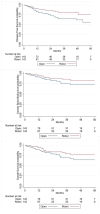Comparing Robotic-Assisted to Open Radical Cystectomy in the Management of Non-Muscle-Invasive Bladder Cancer: A Propensity Score Matched-Pair Analysis
- PMID: 37835425
- PMCID: PMC10571883
- DOI: 10.3390/cancers15194732
Comparing Robotic-Assisted to Open Radical Cystectomy in the Management of Non-Muscle-Invasive Bladder Cancer: A Propensity Score Matched-Pair Analysis
Abstract
Background: For non-muscle-invasive bladder cancer (NMIBC) requiring radical surgery, limited data are available comparing robotic-assisted radical cystectomy with intracorporeal urinary diversion (iRARC) to open radical cystectomy (ORC). The objective of this study was to compare the two surgical techniques.
Methods: A multicentric cohort of 593 patients with NMIBC undergoing iRARC or ORC between 2015 and 2020 was prospectively gathered. Perioperative and pathologic outcomes were compared.
Results: A total of 143 patients operated on via iRARC were matched to 143 ORC patients. Operative time was longer in the iRARC group (p = 0.034). Blood loss was higher in the ORC group (p < 0.001), with a consequent increased post-operative transfusion rate in the ORC group (p = 0.003). Length of stay was longer in the ORC group (p = 0.007). Post-operative complications did not differ significantly (all p > 0.05). DFS at 60 months was 55.9% in ORC and 75.2% in iRARC with a statistically significant difference (p = 0.033) found in the univariate analysis.
Conclusion: We found that iRARC for patients with NMIBC is safe, associated with a lower blood loss, a lower transfusion rate and a shorter hospital stay compared to ORC. Complication rates were similar. No significant differences in survival analyses emerged across the two techniques.
Keywords: cystectomy; intracorporeal urinary diversion; non-muscle-invasive bladder cancer; open radical cystectomy; robotic-assisted radical cystectomy.
Conflict of interest statement
Thierry Quackels: healthcare professional services agreement with Intuitive Surgical. Gregory Verhoest: healthcare professional services agreement with Intuitive Surgical. Others authors have nothing to disclose.
Figures
References
-
- Cumberbatch M.G.K., Jubber I., Black P.C., Esperto F., Figueroa J.D., Kamat A.M., Kiemeney L., Lotan Y., Pang K., Silverman D.T., et al. Epidemiology of Bladder Cancer: A Systematic Review and Contemporary Update of Risk Factors in 2018. Eur. Urol. 2018;74:784–795. doi: 10.1016/j.eururo.2018.09.001. - DOI - PubMed
-
- Babjuk M., Burger M., Capoun O., Cohen D., Compérat E.M., Escrig J.L.D., Gontero P., Liedberg F., Masson-Lecomte A., Mostafid A.H., et al. European Association of Urology Guidelines on Non–muscle-invasive Bladder Cancer (Ta, T1, and Carcinoma in Situ) Eur. Urol. 2021;81:75–94. doi: 10.1016/j.eururo.2021.08.010. - DOI - PubMed
-
- Shabsigh A., Korets R., Vora K.C., Brooks C.M., Cronin A.M., Savage C., Raj G., Bochner B.H., Dalbagni G., Herr H.W., et al. Defining early morbidity of radical cystectomy for patients with bladder cancer using a standardized reporting methodology. Eur. Urol. 2009;55:164–176. doi: 10.1016/j.eururo.2008.07.031. - DOI - PubMed
-
- Zhou N., Tian F., Feng Y., Zhao K., Chen L., Fan R., Lu W., Gu C. Perioperative outcomes of intracorporeal robot-assisted radical cystectomy versus open radical cystectomy: A systematic review and meta-analysis of comparative studies. Int. J. Surg. 2021;94:106137. doi: 10.1016/j.ijsu.2021.106137. - DOI - PubMed
-
- Liu H., Zhou Z., Yao H., Mao Q., Chu Y., Cui Y., Wu J. Robot-assisted radical cystectomy vs open radical cystectomy in patients with bladder cancer: A systematic review and meta-analysis of randomized controlled trials. World J. Surg. Oncol. 2023;21:240. doi: 10.1186/s12957-023-03132-4. - DOI - PMC - PubMed
LinkOut - more resources
Full Text Sources


